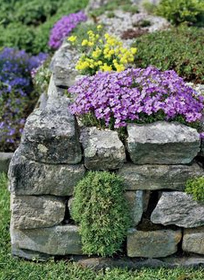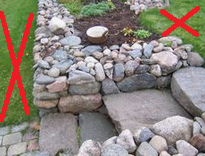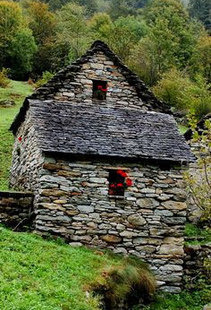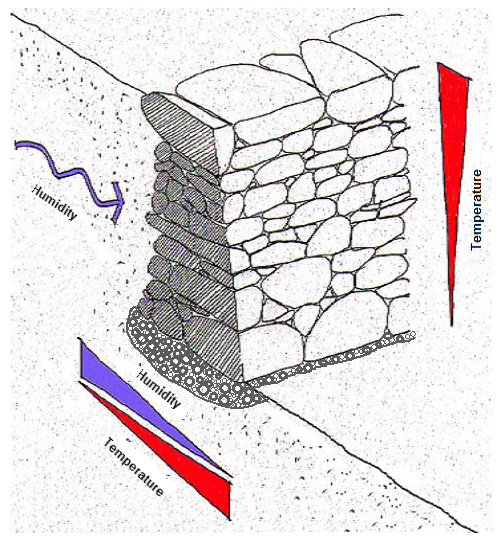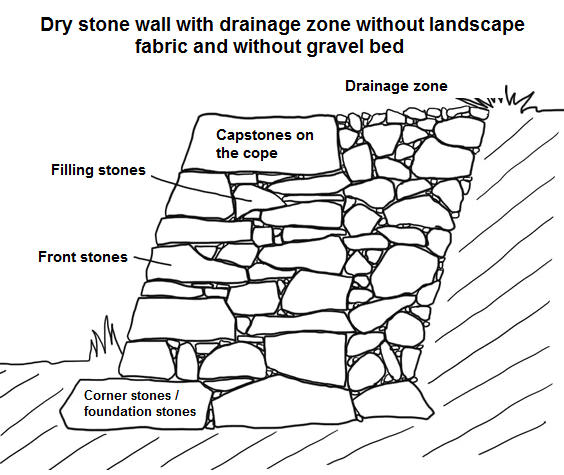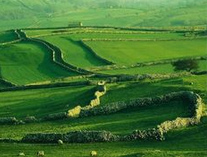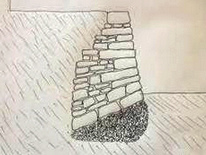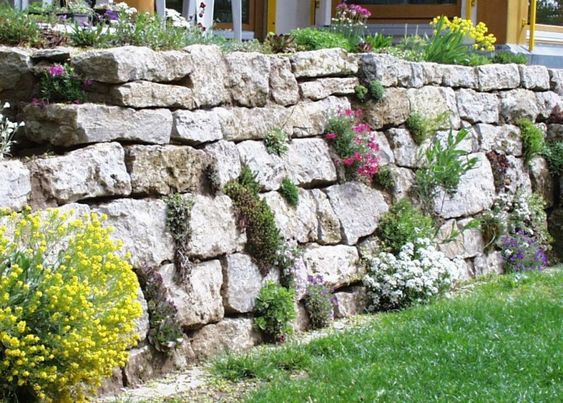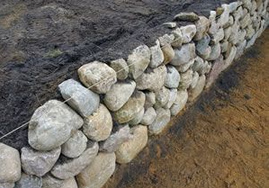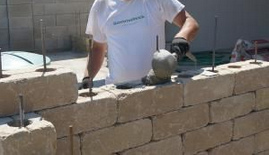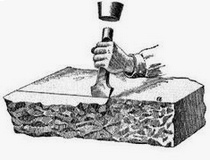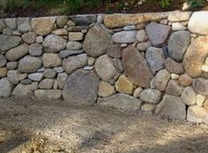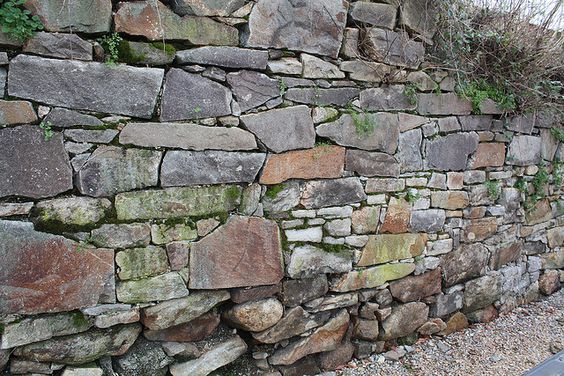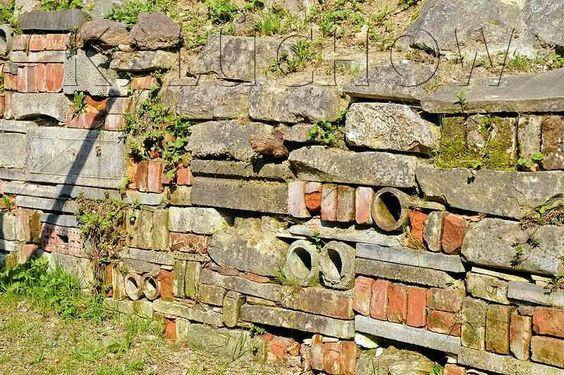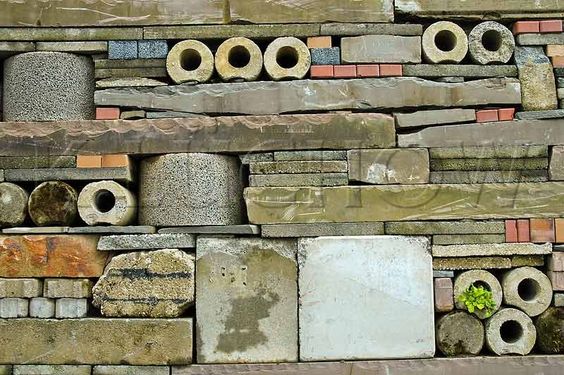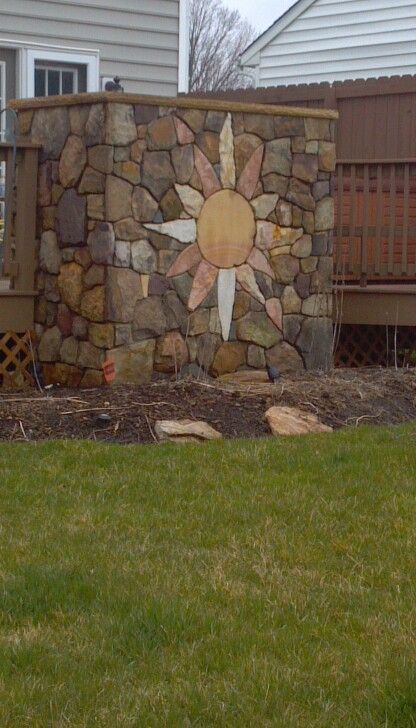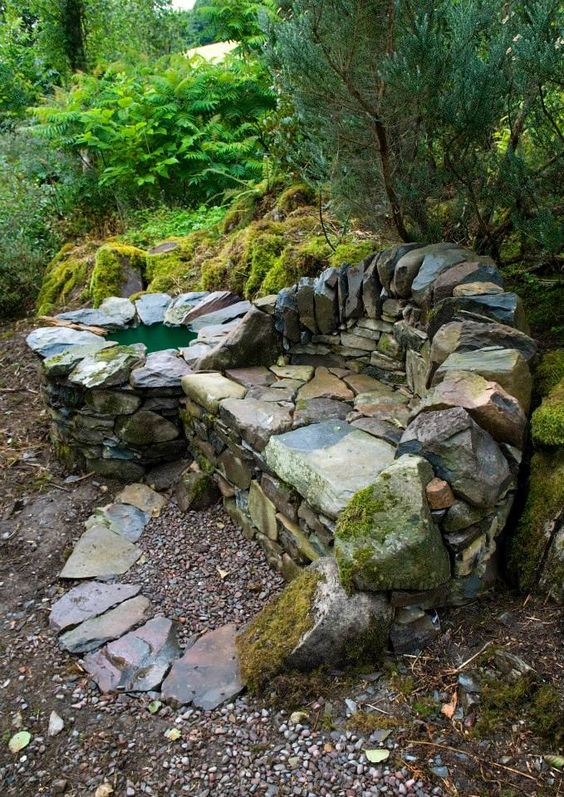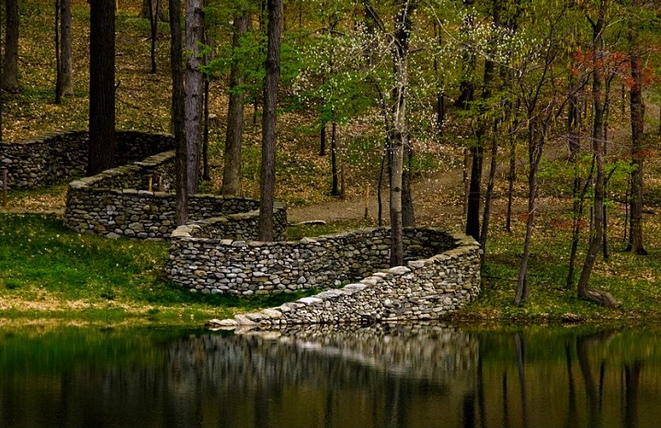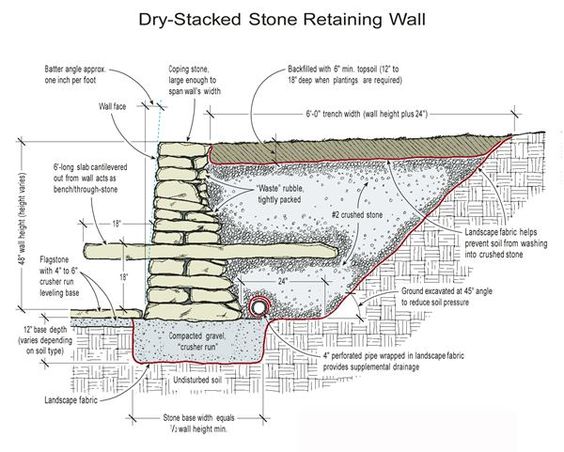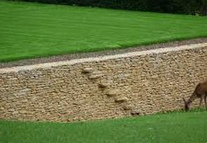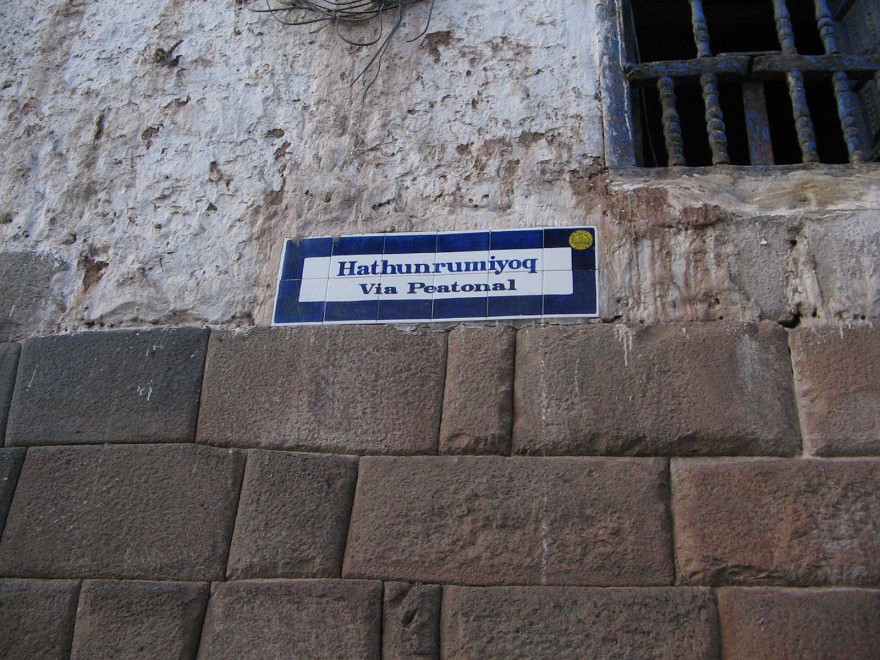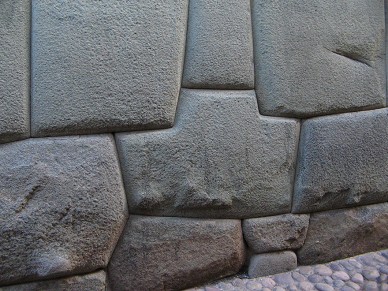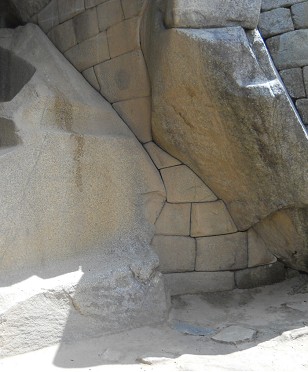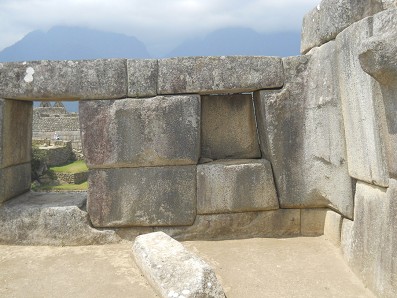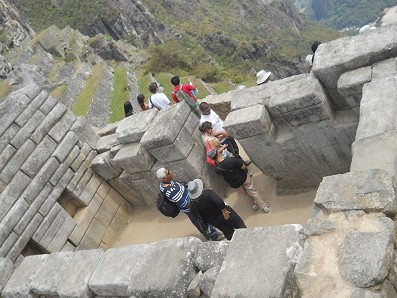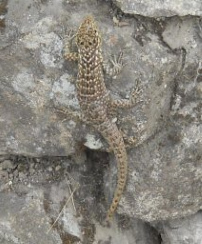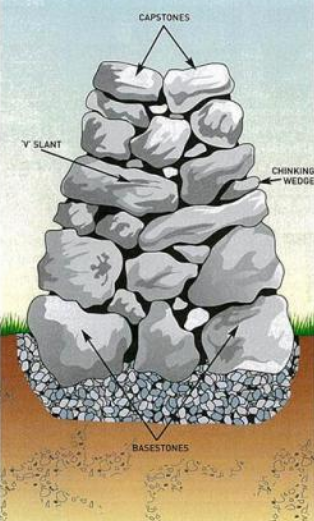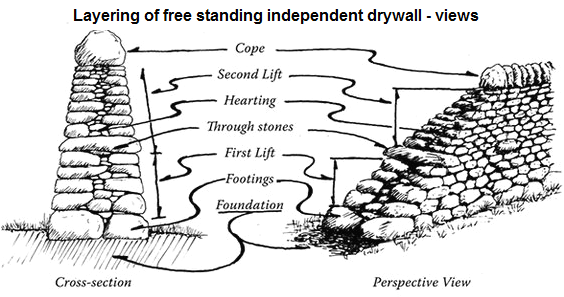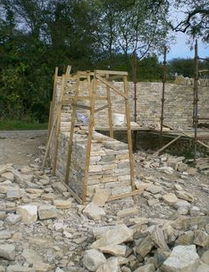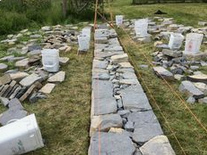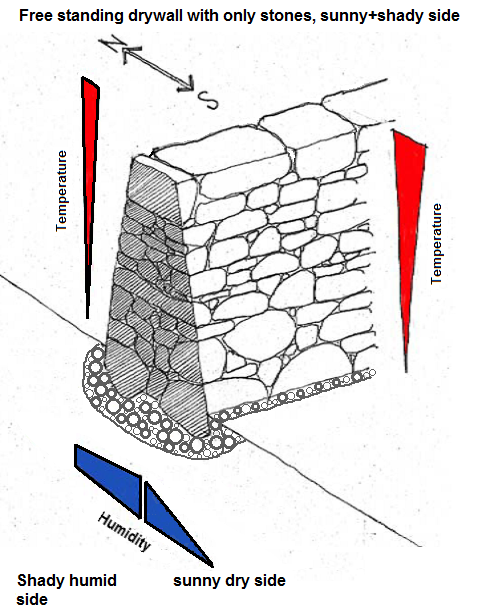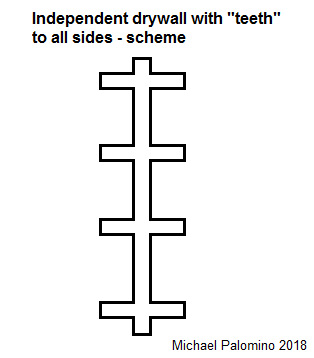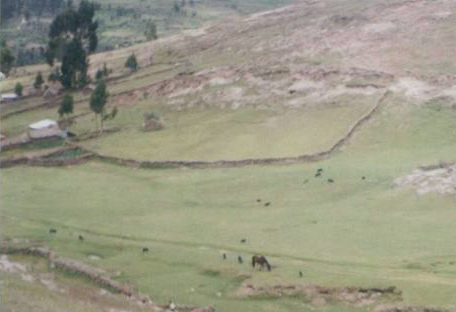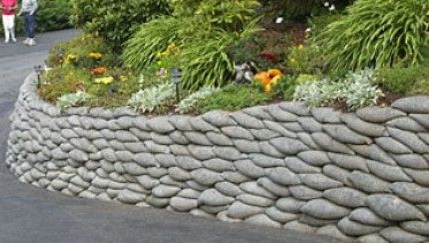|
|
|
Dry stone wall 03 - The construction of dry stone walls
Extention of the eco system with a natural third dimension
Dry wall art with a beaming sun [21]
Rustico dry-stone house in Sonogno, Ticino, CH [34]
1) Dry stone walls - angles, tilts and dryness - the construction -- 2) Stone types, tubes, bricks, artificial figures, snake walls, steps in the wall, walls forming brooks, ponds, pools etc. -- 3) Southern Europe: dry stone houses (Rusticos) - extraterrestrials with dry stone houses in Cusco and Machu Picchu (Peru) -- 4) Install the wall just with the plants -- 5) Free-standing dry stone walls sparsely populated -- 6) With drainage zone with plastic film: desert in dry zones - necessity in humid zones -- 7) Cement sacks wall - absolutely damaging the environment
by Michael Palomino (2018 / 2019)
Share:
|
|
|
Adresses
Criminal Shitzerland (Switzerland): Trockensteinmaurer-Verband www.trockensteinmaurer-verband.ch, mit der Webseite www.stonewalls.ch,E-Mail info@stonewalls.ch [web06, S.1].
========
Variation 1: With gravel below and with lateral connection to the ground: well populated.
Angles and dryness
The angle to increase stability
Retaining walls should have an inclination angle ("dosage") of at least 10 to a maximum of 15 degrees [web01].
Translation: "Make sure that in retaining walls made of formatted bricks (e.g. 10/20/40 cm) at least every tenth brick is installed with its long side perpendicular to the wall length as a "binder brick" to the backfill material. This gives your wall the necessary stability." [web01]
Apparently, the foundation can also be inclined to balance the pressure from the slope:
Dry stone wall on a slope with inclined foundation, cross section [43]
To enable the colonisation of the dry stone wall
When a colonisation of the dry stone wall is wanted, the dry wall must have a direct connection to the ground, at the bottom [with or without a gravel bed] and at the rear with earth contact. So the dry stone wall has a "green foot" and a "green head" as food basis, as hunting ground and as locomotion space [web06, p.9] [and so animals can also dig themselves in for hibernation].
A "dry stone wall" is guaranteed to remain dry with plastic film or fleece on the sides and with a concrete foundation at the foot of the wall with a drainage pipe. The plastic foil (fleece) and the concrete foundation block however roots of the plants and block the burying of the animals for hibernation. Such a wall is guaranteed NOT or hardly populated. Therefore the plastic foil and the concrete foundation are really only recommendable in damp weather zones, but in sunny positions not at all.
The construction
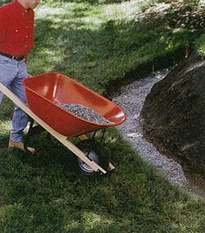

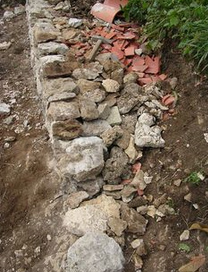
The foundation of a dry wall is filled with gravel [44] - Two-line dry wall on a slope, the foundation and the foundation stones, without gravel bed [14] - dry wall on a slope under construction also with clay fragments in the inner row [15]
First, a trench is dug out to protect against frost [and to infiltrate rainwater] and the foundation is laid with gravel, approx. 30 to 50 cm deep, depending on the subsoil in double to triple wall width. With each layer of stone applied, the gravel in the basement becomes more and more dense and stable [web01].
Translation: "The stones for the dry wall are placed on top of each other layer by layer. Larger cavities between the individual stones can be closed with small stone wedges." [web01]. [web01]
[The wall regularly needs stabilizers, i.e. long stones that extend far into the ground. In humid and tropical zones with a lot of rain, drainage at the rear wall side is absolutely necessary].
According to the regulations (DIN 1053 natural stone masonry) in Germany a stone with visible bearing layers must be installed in such a way that the bearing layers are horizontally visible [web01].
The recommended height of a dry stone wall is 1.5 to 1.8 m maximum. A rule of thumb means, wall height = 1/3 wall thickness [web01].
Depending on the municipality there are different regulations [web04].
Requirements for dry stone walls
Depending on the country, federal state, canton or municipality etc., the regulations for dry stone walls are different:
-- in the garden regulations [web04]
-- in the leasing contract [web04]
-- example city of Braunschweig in Germany: only up to 1m height is permitted, up to 3m length, up to 80cm depth [web04].
-- the stability must be guaranteed [web04].
-- it's well possible that a dry stone wall is rated as a building which must have it's acceptance of construction work by authorities [web04].
The stones for dry stone walls: quarry bricks or masonry bricks
Construction of a dry stone wall with quarry stones directly from the river bed, Gruesch (canton Grisons - CH) 2008 [8] - dry stone wall made of cut stone [9]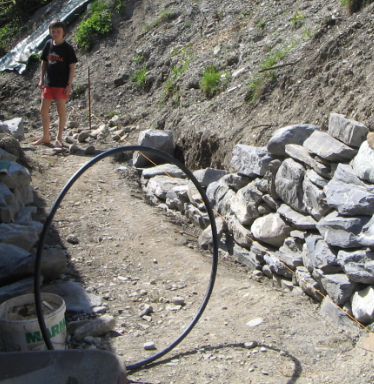
-- there are used irregular quarry stones, as they can be found in the river beds or at a quarry [web01].
or
-- bricks / designed cut stones are used which were split off in the quarry and more or less exactly designed by hammering to build a layered wall [web01].
Single-line dry stone wall as a terrace wall, the wall is "very thin", hardly any animals can nest here, but reptiles and hedgehogs can bury themselves in the earth [10]
Such a simple dry stone wall has to be at a sunny side or all will be always moist and mossy.
Dry stone wall as terrace in the sun overgrown forming different microclimates - combined with a lean bloomy meadow there could develop much life here [12]
or
-- system stones ([garden stones], i.e. sawn concrete stones with possibly sawn "heads" for hooking), which leave hardly any spaces free, and are mostly even mortarized, so there is no space left free at all [web01].
Variation for dry stone walls 02: stone types, tubes, bricks, artificial figures, snake walls, steps in the wall, walls forming brooks, ponds, pools etc.
Stone types for dry stone walls are e.g. sandstone, shell limestone, granite etc. [web01], unprocessed natural stones from limestone, sandstone, mixed field stones etc. [web04].
One can also intentionally install wall bricks or pipes as passageways or nesting places in the dry wall, thus the dry wall becomes a sort of patchwork. So one can recycle remaining building materials [web11].
Dry stone wall with big niches: Sambucs Garden "Jardin Sambucs", Languedoc-Roussillon, France [50]
Where to get the stones: One can get the stones for a dry stone wall from quarries, as a "self-collector" at reasonable prices [web04], or for free from a river.
"Recycling" of old sidewalk slabs: One can also break old sidewalk slabs (break them with a hammer, knock off edges) and lay the edges to the outside, this looks like natural stone [web04].
Masonry bricks are also called like this: monastery bricks - Lion castle - Castle hill - Goseck - system bricks - Do it yourself bricks - ashlar blocks - facing bricks - shell limestone split bricks [web01].
One can also make art with dry stone walls with different types of stone:
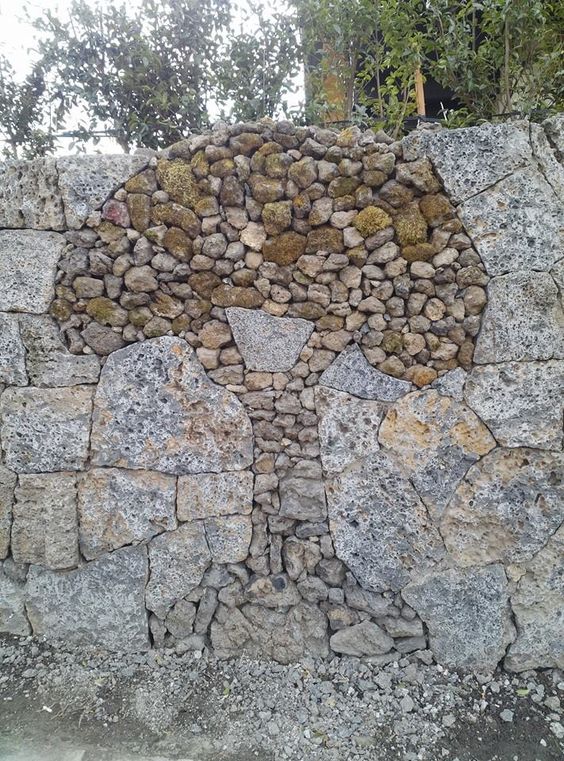
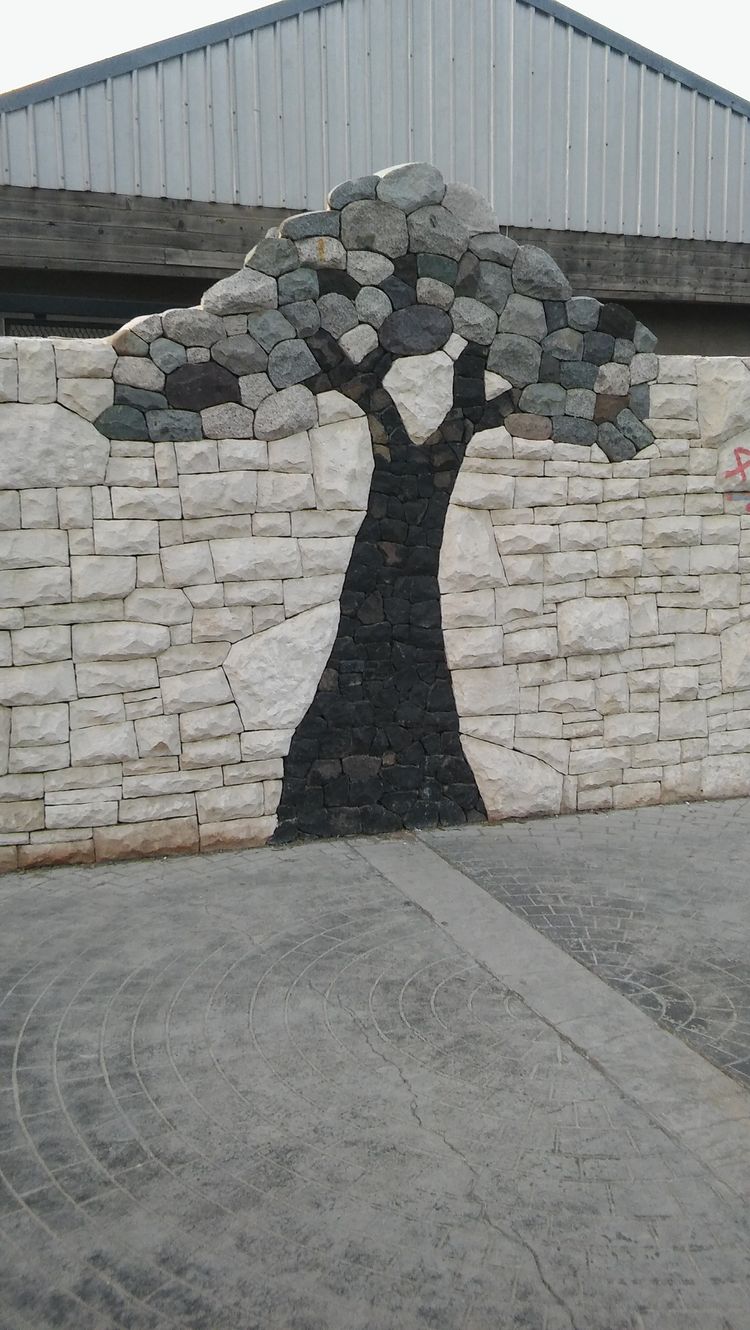
Drywall art using various stones, silhouette of a tree [17] - Drywall art using various stones, silhouette of a tree 02 in Esquel, Argentina [18] - Drywall art using various stones, a star sun [19]
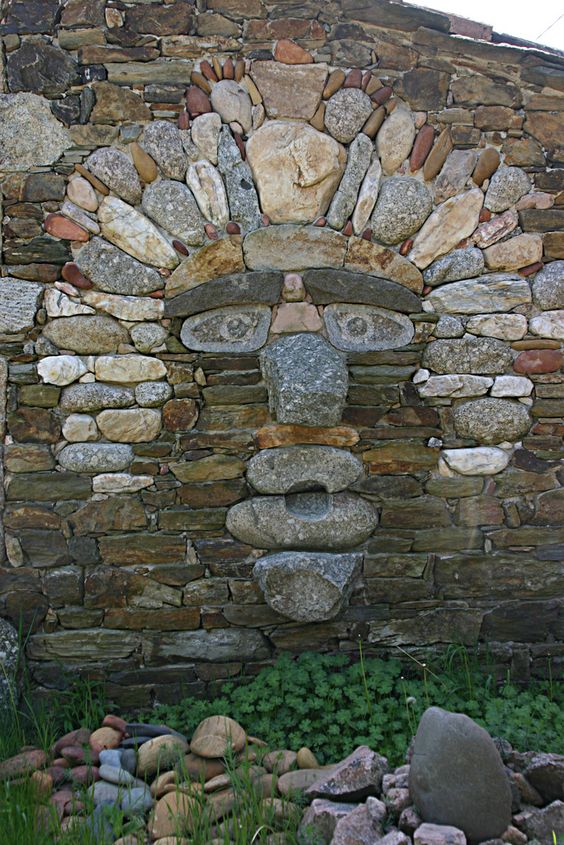
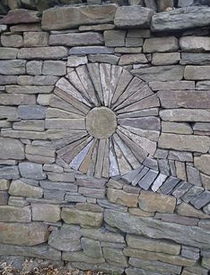
Dry wall art made of various stones, a stone face [20] - Dry wall art with a beamy sun [21] - Dry wall art: a stone sofa and a watering place in the wild garden [22]
In order to create more nesting possibilities, one can also lay snake-shaped or meander-shaped dry walls:

Snake-shaped dry stone wall like a meandering river by Andy Goldsworthy 2001 [52] - Snake-shaped dry stone wall like a meandering river "Storm King Wall" in Mountainville (New York State) 1997 [53]
And of course you can also install stairs in a wall, as the builders of Machu Picchu in Peru already knew:

Dry wall art: Stairs in dry wall terraces of Machu Picchu on the summit of the backyard mountain Huayna Picchu [23] - Dry stoene wall as terrace with integrated step stone, cross-section scheme [31]
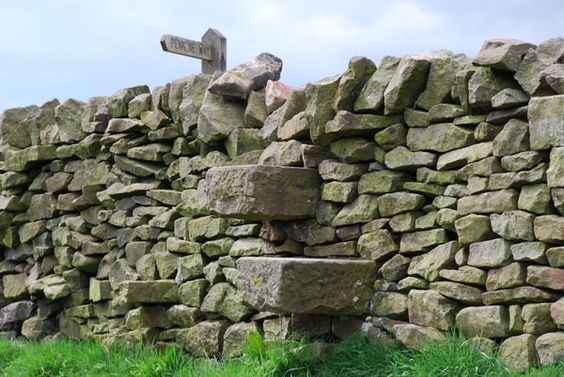
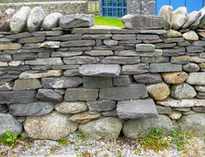
Dry wall with built-in stairs 02 on the Pennine Way from Manchester (England) to Scotland [45] - Dry wall with built-in stairs 03 [46] - Dry wall with built-in stairs 04 [51]
And of course you can also use dry stone walls to build brooks, ponds and swimming pools, so that certain terrestrial aquatic animals can find shelter at the dry stone wall:


Brook and pond with dry-stone walls which then no longer remain dry [24] - Dry-stone wall with integrated swimming pool 02 [47]
The most perfect dry stone walls are the walls of the Peruvian extraterrestrials in the high Andes, but of course nothing grows or settles here:
3. Southern Europe: dry stone houses (Rusticos)
In Southern Europe, entire houses are also built in the form of dry walls. All microclimates with sunny and shady sides are present in Ticino:
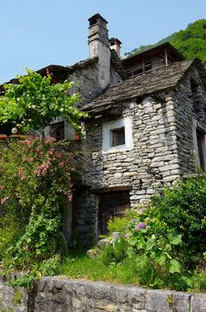
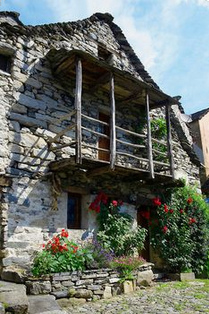
Dry stone house Rustico in Vogorno, Ticino, CH [32] - Dry stone house Rustico in Corippo, Ticino, CH [33] - Dry stone house Rustico in Sonogno, Ticino, CH [34] - Lizards live on the sunny sides of these dry-stone houses in Ticino, South of toxic Shitzerland (Switzerland).
Peru: Houses made of dry stone wall: The dry stone walls of the extraterrestrials in Cusco (Peru) - built to the mm without mortar in around 1200
The most perfect dry-stone walls are the walls of the Inca aliens of Cusco and Machu Picchu in Peru in the high Andes, where the Incas built entire temples and dry-stone buildings. The Inca temples were destroyed by the criminal Catholics, only the foundation walls remain. These dry stone walls are also earthquake-proof with irregular edges inside. Apparently the stones were cut with laser here:
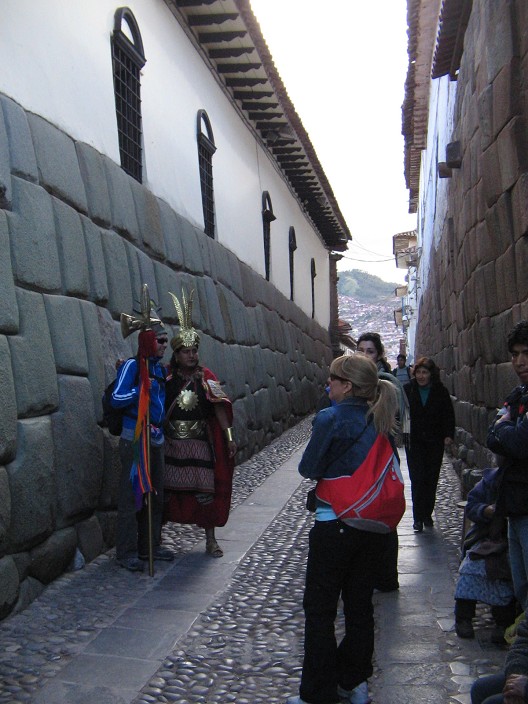
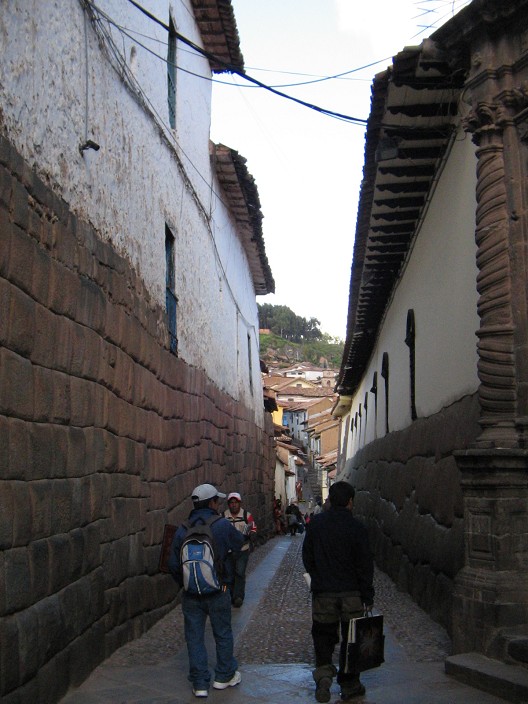
Cusco Jirón Hathumrumiyoq with Inca dry stone walls 1,2 - the street sign
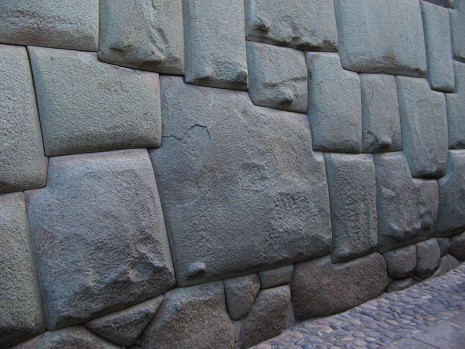
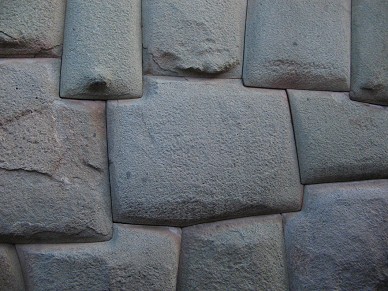
Cusco Jirón Hathumrumiyoq with Inca dry stone wall, 12 cornered stone, 9 cornered stone, 8 cornered stone
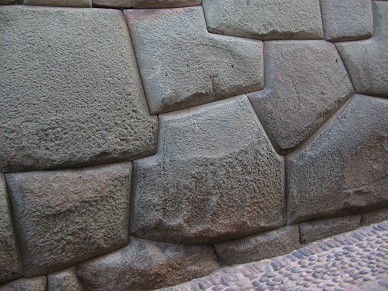
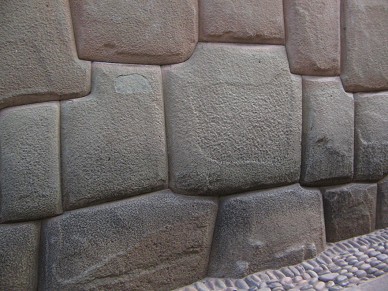
Cusco Jirón Hathumrumiyoq with Inca dry stone wall, 8 cornered stone, and one more 8 cornered stone
Buildings with dry stone walls of extraterrestrials in Machu Picchu (Peru) - built to the mm without mortar around 1200
Link to the whole photo repport about Machu Picchu
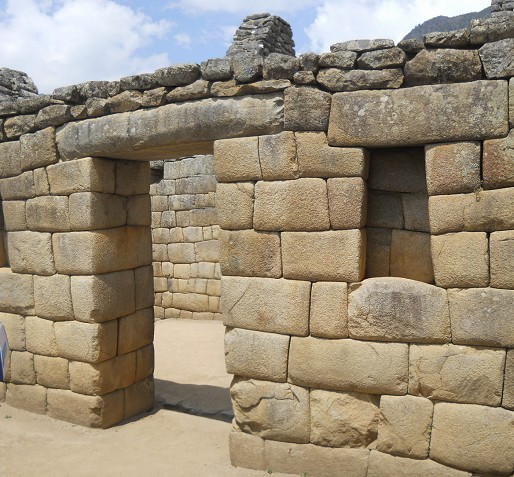
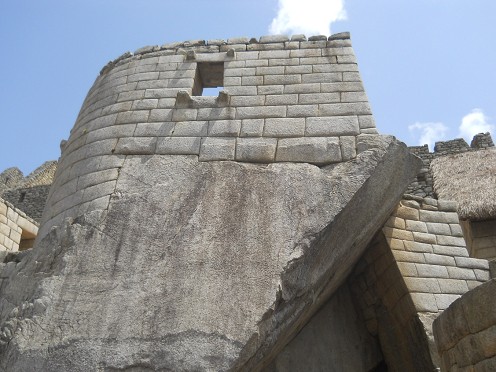
Machu Picchu (Peru), the Inca room with door and niche with perfect dry wall - the sun temple with a curved dry wall - the mummy cave under the sun temple shows a perfect dry wall in double curve
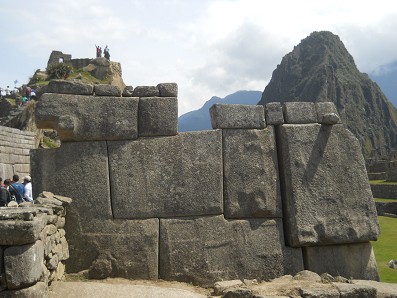
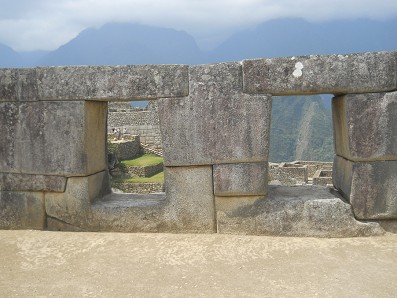
Machu Picchu (Peru), the temple to the 3 winds, drywall 01 - the temple to the 3 winds, windows from perfect drywall 01 - 02 windows with niche
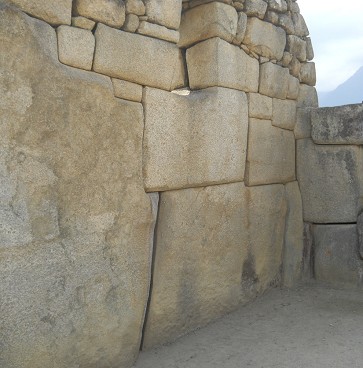

Machu Picchu (Peru), the temple to the 3 winds, perfect dry stone wall 02 - the main temple with its dry stone walls and niches - an earthquake has caused a ground damage which is not repaired yet

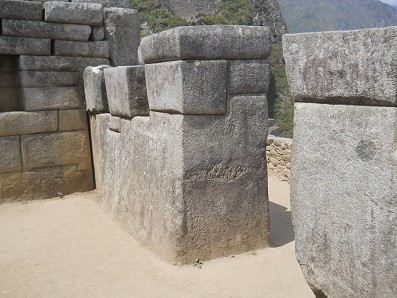
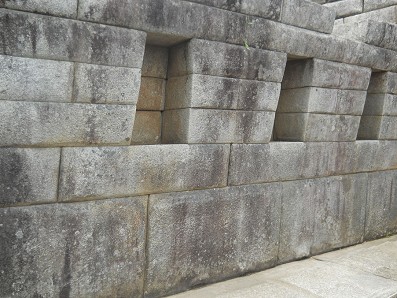
Machu Picchu (Peru), the dry wall meditation room, the 32 corner stone 1,2 - Machu Picchu (Peru), the dry wall meditation room, 3 perfect niches
Machu Picchu (Peru), the meditation room in dry stone wall with the 32-corner stone, view from above
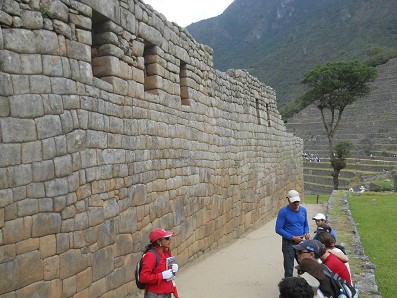
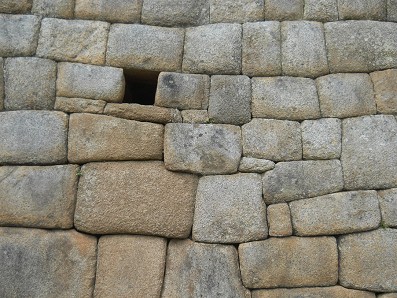
Machu Picchu (Peru), the big dry wall - a drainage
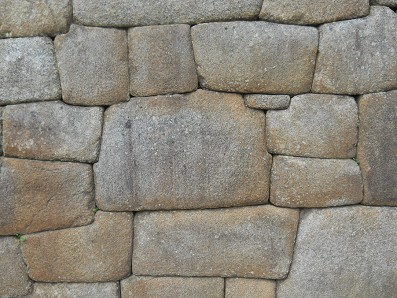
Machu Picchu (Peru), the big dry stone wall, 15-corner stone - 14-corner stone
"Normal" dry-stone walls in Machu Picchu
Of course there are also "normal" dry stone walls in Machu Picchu, e.g. a storage house up on a hill or the workers' houses - there one could see a lizard again which is a clear proof for a "normal" living dry stone wall system with many sunny positions:
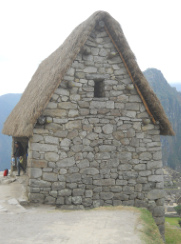
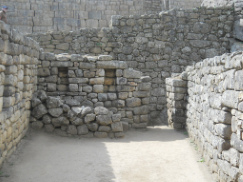
Machu Picchu, a storage house above with "normal" dry-stone walls - worker's houses with "normal" dry-stone walls - and the lizard is a clear sign for living dry stone walls in sunny positions
4. Build dry stone walls variation 2: In the garden install the wall just with the plants - will also be populated.
If planting is planned, gaps and cracks in the walls can be filled during the construction already with potting soil [web05]:
Construction of a dry stone wall: First, the soil is excavated to a depth of about 40 cm and the excavated material is stored. A 30cm high gravel layer is placed in the trench and drained off to compact it. Then 10cm of wall sand is applied and the surface is smoothed with a rake. Now the stones are put on it: At the bottom the largest and widest stones are laid next to each other and filled up with the earth from the excavation above. From the second layer onwards, an inclination of 10 to 15% to the slope is necessary to guarantee stability. So the filled earth cannot push the stones outwards. - Lower area: Animals who cannot climb live in large gaps [mice, wiesel, hedgehog]. - Then comes layer by layer. The spaces in the wall are filled again and again with earth [web04].
Starting from 20cm height one can leave wall gaps purposefully, where root balls fit in (approx. 9x9cm). Plants are suitable, which reach only up to 5cm height, so-called "step plants". From 30cm one can plant cushion shrubs, which spread out like flat cakes on the wall. - The root balls can already be used moist during construction (directly from the water bath, soaked with water), then one has not to "water" them. If one puts plants into the finished wall afterwards, they often fall out and watering becomes difficult [web04].
The planting of the dry stone crown: Suitable plants are those that tolerate extreme dryness: houseleek species (Sempervivum), low-growing sedum such as goldmoss stonecrop (Sedum acre), white stonecrop (Sedum album), Caucasian stonecrop (Sedum spurium), broadleaf stonecrop (Sedum spathulifokum, "Colorado stonecrop") [web04].
The watering of the wall plants takes place via the wall crown: The water is poured into the uppermost cracks and then flows downwards [web04].
5. Build dry stone walls variation 3: free-standing dry stone walls - are sparsely populated
Freestanding dry-stone walls consist of at least two rows of stones that support each other, respectively the rows are inclined [web05]. Each free-standing, "double-faced" natural stone wall has a "front view" and a "rear view" [web01]. For stabilization a filling with earth can be installed in the middle. Single-row, free-standing dry-stone walls should not exceed three stone rows, otherwise there is a danger of collapse [web05].
A free standing "solo" dry stone wall only shows moisture in the lowest part where there is earth contact [web06, p.2]. On a free-standing dry stone wall only plants can exist that survive the dryness with long roots and tricks, the "xerophytes" [web06, p.2].
On a free-standing dry stone wall without soil filling hardly anything will grow and only few animals will settle down, because one cannot form a cave for wintering.
6. Build a dry stone wall variation 4: With gravel or concrete below and with broken stone material or gravel on the side - completely dry: The desert in dry zones - necessity in humid zones
The guaranteed dry dry stone wall on the slope with backfill and plastic film (fleece)
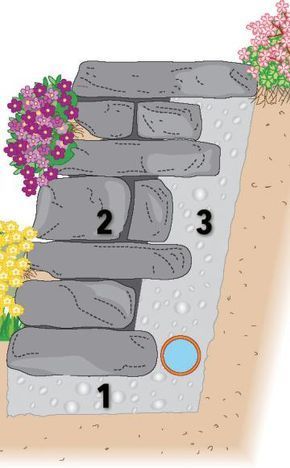
Dry stone wall with desert effect with backfill on the side [3]
1) Gravel bed without film (fleece)
2) Sloping stone wall with binding stones protruding into the backfill
3) Backfilling (drainage ballast or gravel) with film (fleece) on the slope side
4) The blue circle is a drainage water tube with holes.
That dry wall remains a dry desert
In order to make the dry wall "perfectly dry", a plastic filim is placed between the ground on the side and the backfill on the side. In this way, the architects of the "Technical Universities" completed their work and built a sterile desert wall, where NO animal is guaranteed to bury itself for hibernation, and where NO plant is guaranteed to find any hold in the earth behind the wall. This type of dry stone wall in dry climates will rather remain a DESERT.
The dry wall with backfill for shady locations and humid climates
Only in shady locations and in humid climate zones such a construction with a backfill is appropriate to protect the dry wall from too much moisture. Ferns will grow at the bottom of the wall and if there are gaps, a few toads will settle if there is a pond or other water with toads in the vicinity.
For drainage, a perforated drainage pipe can be installed in the gravel behind the first layer, behind the foot of the wall. However, this drainage only works if the gradient angle of the drainage tube is precisely maintained [web08].
[When in a shady position in a humid climate there is a direct, lateral contact to the earth, there will grow mosses, ferns, wild strawberries, mushrooms and a few shade grasses].
Water discharge: dry wall with broken stone material or gravel backfill
A dry wall with a backfill of broken stone material or gravel has a guaranteed water drainage [web01].
A building instruction means (translation):
"For backfilling, we recommend good, drainage-capable material such as drain ballast (washed broken stone material without "0" parts) or gravel (possibly bound with trass cement, as with a "quarry stone wall"). In the case of heavily leaking water, a drainage pipe may be necessary at the foot of the wall. A water-permeable backfilling of the retaining wall should be at least 15 - 20 cm thick, if possible more. (The frequently recommended "dimpled membrane" is no substitute for a drainage backfill!)". [web01]
The binding stones: In order to increase the stability of a dry stone wall with backfill, long "binding stones" can be installed transversely to the wall face inwards so that they extend far into the drainage gravel but have no contact with the ground - preferably 2 to 3 long bricks per m2 [web01].
Sunny sides and dry climate zones: Dry stone walls WITHOUT contact to the ground on the side in medium and dry climates are like a desert, are HARDLY SETTLED, because the animals cannot bury themselves, and so the always dry dry stone walls are of little or NO use to the ecosystem [web06, p.8] except for a few birds and bats.
Therefore dry stone walls remain without settlement
-- when the foundation is made of concrete and any connection to the earth is cut off at the bottom [web06, p.9]
-- when the wall is laterally separated from the earth on the side by a backfill of gravel [web01].
-- when the dry wall is separated from the ground on the side by a plastic film (fleece) etc. [web06, p.9].
North side and humid climate zones: Those who [in humid climate zones on shady slopes] do not apply a backfill of gravel (drain gravel) or gravel will end up with a mossy, always damp wall that does not last long [web01]. But there will grow mosses, ferns, wild strawberries, fungi and a few shade grasses, and toads will settle. However, this only counts for shady sides in humid climate zones.
7. Build a dry stone wall variation 5: The dry wall with cement sacks - the cement sack wall as dry wall (expensive and absolutely harmful to the environment)
Another possibility to build a "dry wall" is to lay cement bags on top of each other and water them. The paper sacks then disappear by themselves over time. What now costs more, real stones or cement bags, is left to the discretion - but some people like these monotonous walls, where all stones have the same form and find it "elegant". One can make cracks wherever it's possible, or no crack at all. Then comes watering of the cement sacks with a garden hose from above, until the cement sacks are all completely soaked with water, and then another 10 minutes pouring the sacks. Then one can leave the wall to itself, the paper bags dissolve day by day more or after a month one can tear them down [web09]. BUT: At the same time too much cement is consumed in the world anyway, and the extraction of sand for cement production increasingly destroys also protected landscapes and sandy beaches. See the website Cement Damage (German). The keyword on the Internet for the search for cement sack protective walls is "concrete bag retaining wall".
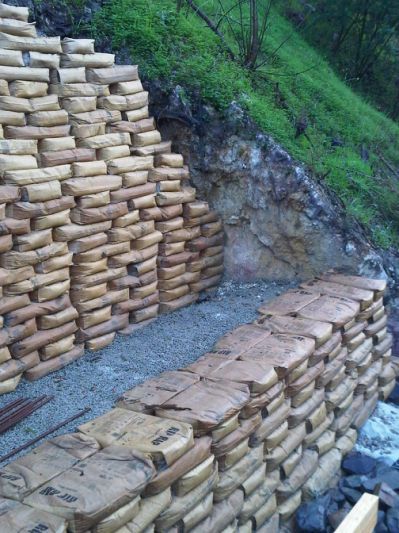
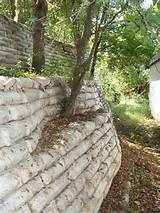
Cement bag wall under construction [38] - Cement bag wall 01 [39] - Cement bag wall 02 with remains of paper bags [40]
One can increase the stability with short and long cement bags:
The criminal cement sack wall: waste of energy - looting of sand deposits etc.
Whether life develops in the cement wall then seems rather doubtful. In any case, the production of cement is anything but environmentally friendly, because 1450şC must be reached in a cement plant. Quote from the CIA Wikipedia (translation):
"Cement is produced in cement works. For its production, the natural raw materials limestone and clay are used, which are often present as a natural mixture and are then called marl. If necessary, quartz sand and substances containing iron oxide are added as correction materials for better sintering. The raw materials are ground to raw powder and then heated at about 1,450 °C until they partially melt together (sintering) and the so-called cement clinker is formed. The now spherical material is cooled and ground to the final cement product. In order to obtain cement types with certain properties, are added suplements before grinding: blastfurnace slag, fly ash, limestone and gypsum can be added in different dosages and grinding fineness." [web10]
Cement works are environmental poisoners with heavy metals in the exhaust air such as mercury, cadmium or thallium. Cement contains soluble chromates with allergic effects (masonry dross). Cement works are recycling waste oil or solvents, recycling household waste, car tyres, animal flower at over 2000şC without harmful exhaust gases [web10].Moreover, far too much cement is already consumed in the world, and the extraction of sand for cement production is increasingly destroying protected landscapes and sandy beaches. See the website Cement Damage (German). A wall made of cement bags is therefore absolutely destructive and should be forbidden.
The best dry stone wall is in sunny positions with direct contact to the earth.
Replace concrete with an earth mixture: earth+water+some cement - architect Raynolds with Earth Ships
It's possible to replace concrete with constructions with an earth mixture: earth+water+some cement WITHOUT sand, see the buildings of Earth Ships of architect Michael Reynolds.
<< >>
